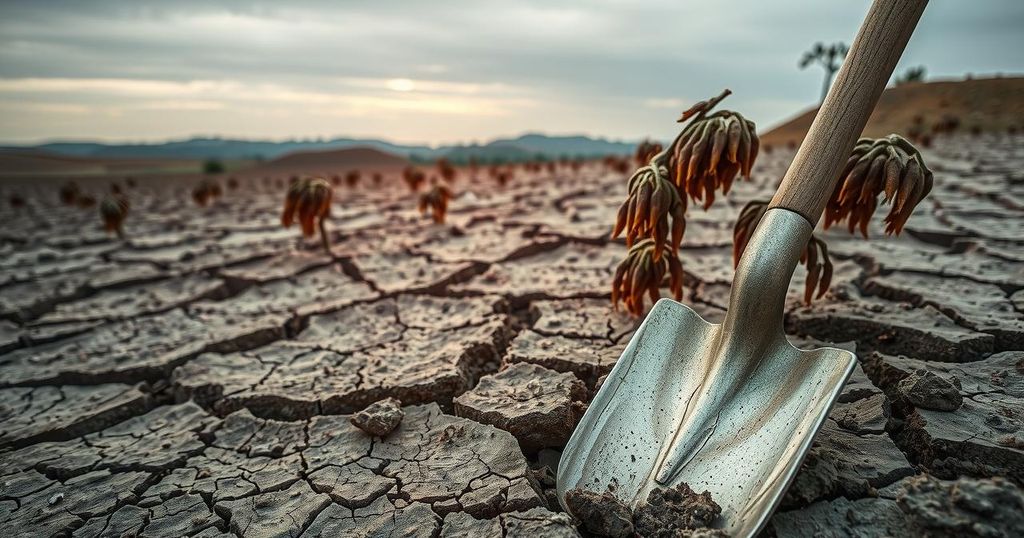A new report reveals that only 20% of Kenya’s soil is suitable for agriculture, with significant degradation threatening food security. Factors such as erosion, overgrazing, and nutrient depletion are major contributors to this crisis. The situation is dire, with projections indicating that 2.8 million people may face acute food insecurity in the coming months, necessitating urgent action to address the soil health crisis and improve agricultural productivity.
A newly released report indicates that merely 20 percent of soil in Kenya is suitable for agricultural activities, presenting alarming prospects for the nation’s food security. The Soil Atlas Health Report 2025 highlights a severe degradation issue, with an annual loss of 26 tons of soil per hectare due to water-induced erosion, and some areas suffering losses exceeding 90 tons. This degradation threatens the agricultural capacity critical to feeding the nation.
Soil plays a crucial role in ensuring food and nutritional security and is essential in combating climate change, as it sequesters more carbon than both vegetation and the atmosphere combined. Plants absorb carbon from the air, which is then stored in soils through their root systems. The report further reveals that the situation is dire in East Africa, where more than 40 percent of soils exhibit degradation, endangering the agricultural foundations of the region.
Human activities and natural occurrences are key factors driving this soil crisis. Practices such as overgrazing, unsustainable farming, deforestation, and the impacts of erratic weather patterns collectively deteriorate soil quality. Overgrazing, especially in arid regions, exacerbates degradation by stripping away vegetation that offers soil protection, leading to increased erosion and reduced water retention for crops.
Salinization also significantly contributes to soil degradation in Kenya, particularly in arid and semi-arid areas. Poor irrigation methods, including the use of substandard water, exacerbate this issue by causing salt levels to rise in the soil. When water evaporates, it leaves behind salts that can reach harmful concentrations, especially under high evaporation rates and waterlogging conditions. “Approximately 40 percent of irrigated land in Kenya is affected by salinity, making it difficult to meet agricultural demands,” according to the report.
Moreover, nutrient depletion is another critical challenge for soil health nationwide, with over 85 percent of soils found to be lacking essential nutrients. Continuous farming without proper replenishment, coupled with rising soil acidity and inadequate management practices, intensifies the nutrient deficiency. Alarmingly, the degraded soils are predicted to diminish agricultural output by up to 30 percent, increasing the likelihood of dependence on food imports.
This troubling situation coincides with findings from the National Disaster Management Authority (NDMA), which reported an alarming 2.8 million people in Kenya facing acute food insecurity between April and June 2026 due to anticipated insufficient long rains. The NDMA’s assessment of 23 Arid and Semi-Arid Lands (ASAL) counties revealed that 650,000 additional individuals are now in urgent need of humanitarian assistance, increasing the total from 2.15 million.
Among those affected, children aged six months to six years and breastfeeding mothers in these vulnerable regions are at heightened risk of experiencing acute malnutrition. This multifaceted crisis underscores the urgent need for comprehensive strategies to restore soil health and enhance food security in Kenya and the wider East African region.
The findings of the Soil Atlas Health Report 2025 underscore the grave challenges facing Kenyan agriculture, with only 20 percent of the soil deemed suitable for food production due to alarming levels of degradation. The confluence of unsustainable practices, salinization, and nutrient depletion threatens the food security of millions, heightened by the impending risk of acute food insecurity affecting nearly 2.8 million people. Addressing these issues is imperative to restore soil health and secure the livelihoods of those most vulnerable.
Original Source: www.kenyans.co.ke






